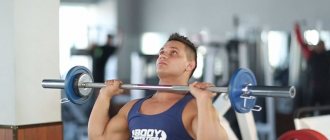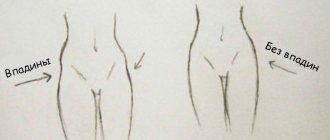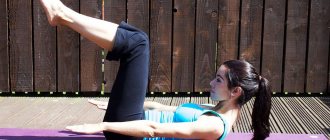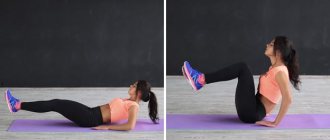What is this exercise and who invented it?
Walking on the buttocks is a unique exercise that trains the muscles of the pelvic area, strengthening their tone. The universal benefit of this fairly simple training method is that it engages multiple muscle groups and organ systems in the body, resulting in profound health benefits.
The complex therapeutic effect of “walking on the buttocks” was described by Professor I. P. Neumyvakin back in 1070, and since then the exercise has gained popularity due to its beneficial properties in the treatment of a number of diseases of the pelvic region, in particular:
- constipation;
- prostate adenoma;
- haemorrhoids;
- gynecological problems;
- prevention of spinal problems;
- normalization of intestinal function.
Walking on the buttocks also helps strengthen the spinal, abdominal, and gluteal muscles, helping with problems that are associated with harm from poor blood circulation in the pelvic area, such as cellulite and obesity.
Interestingly, Professor Neumyvakin developed an original system of exercises for the pelvis, in which walking on the buttocks was a basic technique that has a strong beneficial effect on the systems of various organs. At the same time, the author considered the key to health to be the property of exercises to influence the contraction of the gluteal muscles on the intestines to normalize its work, not only by removing toxins from the body, but also by strengthening the immune system.
An important property of the buttock walking technique is that the exercise does not require special sports equipment, it is easy to perform at home, and even if there are no fitness dumbbells, you can get by with an ordinary plastic bottle.
Everything ingenious is simple: a wise proverb well reflects the essence of a useful technique for the gluteal muscles. It is really not difficult to perform it, since it requires a minimum of time and effort, but it requires regularity.
Recommended reading: Benefits of walking
Theory and history
Exercises will help not only get rid of cellulite, but also keep the intestines in excellent condition. The simplicity of gymnastics will allow you to perform these exercises anywhere and anytime.
Many famous doctors develop their own gymnastic exercises for the treatment and prevention of diseases. Walking on the buttocks appeared in the early 70s, the author of gymnastics is Doctor of Medical Sciences, Professor I.P. Neumyvakin.
According to the scientist, a healthy body depends on the smooth functioning of the gastrointestinal tract. If problems with digestion appear, this inevitably leads to the appearance of chronic diseases. The professor himself invented many physical techniques, was distinguished by good health and lived to be 90 years old.
Fact. Soviet medical colleagues greeted the new exercises with approval and began recommending them to their patients. Reviews from doctors and patients were not long in coming, and now this gymnastics is recommended from Russia to Brazil.
What are the benefits of walking on your buttocks?
The main benefit of walking on the buttocks is achieved primarily due to its ability to improve blood circulation in the pelvic area. This gives exactly that invaluable effect for which walking on the buttocks has become so widespread among supporters of a healthy lifestyle and even in fitness training.
What does walking on the buttocks according to Neumyvakin give to the organs and systems of the body:
- Prevention of harm from diseases of the pelvic area: constipation, hemorrhoids, enuresis, radiculitis.
- Elimination of swelling of the legs.
- Normalization of the digestive system.
- Strengthening the sacral and lumbar spine and the musculoskeletal system as a whole.
- Tones the muscles of the buttocks, abs, legs and back.
It is also worth noting the undoubted importance of the beneficial properties of walking on the buttocks for people with limited mobility.
Walking on the buttocks with hemorrhoids: how and when to do it?
Do you suffer from hemorrhoids? Have you wondered how and when to practice walking on your buttocks in order to get maximum results and not remember the terrible diagnosis? Most often, prevention (and walking on the buttocks is prevention, not treatment) is remembered at the time of exacerbation. But at the moment when hemorrhoids are inflamed, the nodes come out of the anus - physical exercise is strictly contraindicated.
The first thing to do is to relieve inflammation and put the disease into remission. But if you have never encountered hemorrhoids, but know that your parents or blood relatives suffer from this disease, do not wait for the disease, but start prevention in advance.
So, is your condition normal at the moment? So, urgently start walking exercises on your buttocks. If you have hemorrhoids in remission, start with 5 minutes and add 1 minute every day, regardless of your level of training.
The benefits of walking on the buttocks for women
The topic of reproductive function is especially relevant for women. Professor Neumyvakin’s exercise helps to work, including with gynecological diseases, by increasing blood circulation in the pelvic organs, helping in the treatment of problems such as endometriosis and adhesions.
Even such an inconvenience as familiar to most women as pain during menstrual periods is solved. Regular exercise can provide benefits, including complete relief from pain.
To lose weight and maintain slender thighs, you can also use the beneficial properties of walking: while doing it, tension in the muscles of the buttocks, abs, and back helps increase joint mobility and straighten posture.
In addition to the general therapeutic benefits, walking with the buttocks for women, due to the property of strengthening the muscles of the pelvic area, has specific advantages associated with the characteristics of the female body:
- Cellulite holds the undisputed primacy in this: regular walking on the buttocks will have an excellent smoothing effect on subcutaneous inflammatory processes and uneven surfaces. The buttocks and thighs will inevitably tighten and gain elasticity.
- Another “female” problem that can be solved well by walking on the “fifth point” is the fight against the harm of extra pounds in the buttocks and pelvis. Another “inconvenient” problem that has been talked about only recently is involuntary urination, associated with special age-related properties - the benefits of walking on the buttocks here will be undeniable.
Advice! To combat extra pounds and cellulite, before starting a walking workout, you should apply anti-cellulite cream or wrap yourself in cling film.
We recommend reading: Anti-cellulite massage: effect, technique, photos and videos
The technique is so effective that many girls boast online about the benefits they get from walking on their buttocks, posting before and after photos.
For more information on how to effectively use the anti-cellulite technique, watch the video:
The benefits of walking on the buttocks for men
Strengthening the pelvis for men is no less important: I. S. Neumyvakin especially emphasized the ability of walking on the buttocks to help in solving the main male problems:
- Potency, which is provided by the tone of the gluteal and pubococcygeus muscles.
- Prostate adenomas are the scourge of modern men: walking on the buttocks perfectly helps to work with prostatitis at the level of restoring proper physical activity.
The whole secret lies in the same beneficial property of exercise to increase blood circulation in the pelvic organ systems: this is the main condition for men’s health, the violation of which provokes all the unpleasant consequences.
Pros and cons of glute walking
As with any physical activity, butt walking also has its advantages and disadvantages. Pros:
- Absolutely non-traumatic type of exercise. It is simply impossible to get injured while sitting on the floor.
- Even a person with little training in sports can easily perform this physical therapy exercise.
- Saving. Buttock walking can be done at home without spending money on a gym membership. Actions to combat cellulite can be easily done on your home mat.
There are also some disadvantages:
- Butt walking is not comparable in load to a full workout in the gym. For beginners, this is the best option. But for more advanced athletes, it looks more like a warm-up. And along with this walking, they need to do additional exercises.
- Such walking is not fully capable of working the gluteal muscles. This is just superficial training. To improve the effect of elasticity of the buttocks, it is necessary to supplement it with deep squats.
Walking on the buttocks for weight loss
The benefits of walking on the buttocks for weight loss will be especially strong when combined with diet, massages and dynamic training.
Interesting! In fitness training, walking on the buttocks is used as a warm-up for the pelvic area.
The first benefits of the exercise can be seen after a month of regular performance: not only the buttocks, but also the associated muscles of the legs and thighs will gain elasticity.
But, of course, it is worth working patiently to receive such a reward.
And let it inspire you to realize that such formation of a beautiful body is accompanied by bonuses in the form of strengthened immunity, improved condition of skin, nails, hair - and all this thanks to a simple technique.
Execution technique
So, after studying reviews about the benefits for women of the exercise walking on the buttocks, we concluded that the result will appear only if it is performed correctly. Let's study the main nuances of the technique:
- Any workout always begins with warming up all parts of the body. Pay special attention to body bends and squats. By the way, in order to pump up your butt, squats are simply irreplaceable;
- During movement, the arms are raised up and secured in a lock at the back of the head. If you feel that you are losing your balance, you are allowed to swing your arms bent at the elbows, maintain balance and return them to their original position;
- They sit on the floor, keeping their torso straight, strictly perpendicular to the floor. Neck straight, look forward;
- The stomach must be pulled in, the shoulders must be pulled back;
- Legs bend at the knees and relax. They should not participate in walking; the buttocks do the main work;
- They move slowly, without jerking, 5-7 cm in one “step”;
- Allowed to “walk” forward and backward;
- The duration of one workout is 10-15 minutes.
We reviewed the reviews and results of walking on the buttocks for weight loss and came to the conclusion that this exercise is indeed very effective. It does not require very much effort and does not take much time. If you want to have a round and beautiful butt, be sure to train every day, without skipping. Don't forget about proper nutrition and an active lifestyle. In addition, for peace of mind, you can add meditative walking. It's easy to do and helps you get into the right frame of mind.
Warm up before doing the exercise
The correct execution of walking on the buttocks must always begin with a warm-up. This will warm up the body well and prepare it for further stress.
- You should start by establishing breathing using slow inhalations and exhalations, up to 10 cycles. It is important not to skip this part, as it promotes oxygenation of the tissues and reduces the production of lactic acid after walking.
- Then continue with traditional circular movements of the head, bends to the sides, and circular movements of the legs.
- Stretching is the third important part of the warm-up, which helps to deepen the preparation of the muscles of the entire pelvis:
- lie on your back and bend one leg at the knee;
- pull it well with your hand to your chest;
- fix in this position for 30 seconds;
- repeat everything for the other leg;
- then pull both legs towards the chest, helping with your hands.
Option for advanced: enhancing the effect of stretching can be done with an outstretched leg. Additional complication can be achieved by performing “steps” to the sides.
How to walk on your buttocks correctly
Now is the time to start walking.
During the development of this technique, five modifications of varying complexity were formed. It’s worth starting with the simplest, classic version and increasing the load as you train, moving to new levels of performance.
Important! To work deeply and get the maximum possible benefit, you need to perform all exercises consciously, “listening” to the sensations from your muscles.
Option one
- It is necessary to straighten your back and continue to keep it straight.
- Bend your elbows and press them towards your body. They must be kept pressed throughout the entire exercise.
- Spread your legs to a distance equal to shoulder width.
- Tighten the muscles of your buttocks and legs as much as possible.
- Take a “step” forward with one leg, and also transfer your body weight to this leg with a movement of small amplitude (approximately 5 cm).
- Repeat the same sequence for the other leg.
- “Walk” in this way a comfortable distance (about 2 m) forward.
- And go back, performing reverse movements with your legs.
Option two
Making the workout more difficult:
- Sitting on a karimat or covering, place your feet shoulder-width apart.
- Stretch your arms forward parallel to the floor.
- Shift your body weight to your left side.
- Move your right leg forward.
- Your arms will naturally move to the right, and your head will turn to the left to maintain balance.
- The movement will be mirrored when moving the left leg forward.
- Proceed to the end and return in reverse.
Option three
New level of difficulty: walking on your buttocks with bent legs.
- The position is basic.
- Bend your legs at the knees and press them to your chest with your hands.
- Walk all the way forward and backward.
Option four
Making it more difficult: walking on your butt with your arms raised.
This level works well with the abdominal muscles and has maximum effect on the gastrointestinal tract.
- Take the basic position.
- Raise your hands behind your head. You can bring your brushes together into a “lock”.
- “Walk” your buttocks forward and back.
Option five
For glute walking aces: bottle technique:
- Prepare a plastic bottle with a volume of half a liter to a liter. When ready to increase the load, it can be filled with water.
- Sit in the basic position.
- Grab the bottle between your ankles.
- Walk on your buttocks for 2 meters, turning your body to the right, the next 2 meters - turning to the left.
How to do the exercise correctly
To begin with, to ensure that the exercise brings benefits to the muscles and ligaments, and not harm, do a warm-up, which includes dynamic exercises (warm-up of muscles and joints) and stretching exercises. Although visually keeping your back at a right angle with straightened knees seems simple, but for many it will become a problem due to inflexible and inelastic ligaments and muscles. Tightness of the lumbar region, buttocks and biceps of the thigh leads to the fact that the torso cannot maintain a straight line of the spine. To do this, the back of the body needs stretching, which is achieved by gently bending forward while sitting on the buttocks, holding the pose for a while. Gradually the muscles and ligaments will lengthen.
After warming up, sit on your buttocks:
- Straighten your back, the spine should maintain a vertical line without rounding at the lower back.
- Extend your legs in front of you, tighten your thigh muscles and straighten your knees without bending during the exercise.
- Keep your arms straight in front of you, parallel to your hips. To make it more difficult, you can hold your hands behind your head.
- Tighten your abdominal and buttock muscles and begin to walk your right leg forward, lifting your right gluteal muscle and moving it slightly forward. Try not to fall apart when walking, maintain the axis of the spine.
- Immediately move your left leg forward, and thus move gradually forward. Perform the movements slowly, concentrating on the work of the buttocks and the straight line of the spine. Do not bend your knees, all the muscles of the body are tense like strings. The top of the head extends to the ceiling.
- Calculate the number of steps and perform the reverse movement with your back, also pay attention to the technique. Breathe evenly and calmly.
Walk for a while, start with one minute, this will be enough for the buttocks to be well loaded. Rest for a minute and repeat 2-3 rounds. Increase the time each workout. Don't forget to stretch your muscles after exercise.
Recommendations for performing the exercise
To perform the exercise effectively, you must follow simple rules:
- The back must be kept straight, so that when performing the exercise there is an angle of 90° between the body and legs.
- The use of the arms is limited to natural movements, such as the swings of walking or running, which will help maintain balance. Other hand activities should be excluded so that the main payload goes to the hip joints and associated muscles.
- When taking a “step” with your buttocks forward, you need to keep your leg suspended without touching the floor.
- The load should be increased gradually, starting with two approaches of 15 “steps” and developing up to 8–9 approaches of 40–50 “steps” per day.
- To increase further load, you can use fitness dumbbells or bottles filled with water.
- Concentration should be on the muscle groups that we load, as well as on the technique of the exercise itself: the key word here will be “quality” of execution.
- To create an optimal level of load, you should perform the exercise on a surface where there will be friction force: for example, with a fleecy coating or on a carpet.
- To prevent abrasions on the buttocks, it is better to wear rubberized sports leggings, and also use a non-slip surface or a carpet type mat.
- And if the skin does suffer from stress and is peeling or irritated, this problem should be solved by using olive or other vegetable oil, as well as a rich cream.
- If you feel pain in the lower back or abdomen, you should stop walking: further loading may be excessive.
Tips for implementation
There are a number of recommendations and rules that must be followed when walking on your butt.
Top tips:
- The back should be straight - even a slight stoop will negate the benefits of the exercise.
- You cannot focus on your hands and use them as a fulcrum. It is only allowed to perform swings, simulating running and maintaining balance.
- When the leg moves forward, you should try not to “drag” the gluteal muscles along the floor, but keep it straight and weighted.
- To prevent calluses from appearing on the skin, it is recommended to wear smooth clothes and lubricate the skin with rich cream or olive oil.
- You should not overload at the initial stages of training. You should start with 2 repetitions and 15 steps, gradually increasing the distance to 5 meters or 40-50 steps.
And remember that you should focus on correct technique, not on the number of repetitions.
Possible harm and contraindications for implementation
The exercise walking on the buttocks is universal and is limited to a minimum of contraindications, but they do exist, and before deciding to carry out useful training, it is important to remember the cases when it is advisable to abstain from them:
- during menstruation;
- in the first trimester of pregnancy;
- during exacerbation of chronic problems in the pelvic area and spine;
- with exacerbations of hemorrhoids.
You should also carefully study all the nuances of performing therapeutic walking so that the benefits do not turn into harm from unforeseen consequences: incorrect execution technique can dilute the beneficial effect of the exercise and even lead to pain in the lower back and abdomen. However, for inactive people, pain may also be the norm, associated with adaptation and the release of lactic acid.
Another “harm” of walking on the buttocks manifests itself in the form of irritation on the surface of that part of the thighs that comes into contact with the hard surface of the floor.
Performance technique
How to walk on your butt correctly? There are 5 ways to perform the “walking on your buttocks” exercise. When doing exercises, you should listen to your body, and if you have pain in the lumbar region or lower abdomen, you should stop training. However, it is important not to confuse the pain with muscle pain that occurs due to physical activity.
Method one - classic
- Sit on your butt (preferably on a fleecy surface).
- The back is in a straight, vertical position.
- Bend your arms at the elbow joint, pressing them to your body.
- Legs should be spread apart at shoulder distance.
- You need to tighten your gluteal and leg muscles as much as possible.
- Move your left leg slightly forward and shift your body weight to the left approximately 5 cm. Elbows should not come off the body. The back remains straight.
- Perform the movement with your right leg.
- Also walk across the floor on your buttocks backwards.
Method two
- Sit on the floor or a special mat.
- Spread your legs at shoulder level and extend your arms in front of you, parallel to the floor.
- Shift your body weight to your left buttock and move your leg forward slightly. Also tilt your head to the left and your arms in the other direction.
- Repeat movements with your right leg.
- Perform the same walk backwards.
Method three
- Sit on the floor or mat.
- Bend your legs at the knee joint.
- Pull your knees towards your chest.
- Move forward, then back on your buttocks.
Method four
Strengthens the abdominal muscles and improves the functioning of the gastrointestinal tract.
- Take a sitting position.
- Place your hands behind your head.
- Move on the buttocks, as in the previous exercises.
Method five - more difficult
- Sitting position.
- Place a plastic bottle of 0.5 - 1 liter in volume between your feet.
- Walk in this way on your buttocks for two meters, turning your body to the right, then another two meters, turning your body to the left.
Dr. Bubnovsky, who is also developing unique methods for restoring the body, describes in his works the technique of walking on his knees.











